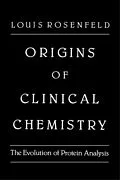Origins of Clinical Chemistry: The Evolution of Protein Analysis covers the history of the application of analytical methods to the plasma protein analysis. This book is divided into 20 chapters that consider the relationship between the limitation of technical accuracy and clinical interpretation. The introductory chapters provide an overview of the concept and issues in protein chemistry, as well as the history of organic chemistry. The succeeding chapters deal with the classification, detection, fractionation, and analysis of proteins. Considerable chapters are devoted to various analytical techniques for protein analysis, including colorimetry, photometry, Svedberg technique, ultracentrifuging, zone electrophoresis, immunohistochemical methods, and radioimmunoassay. The remaining chapters examine the detection and analysis of proteins in several body fluids, such as urine and cerebrospinal fluid. This book will be of great value to clinical, analytical, and organic chemists, as well as to protein scientists and researchers.
Inhalt
Preface
Acknowledgments
Introduction
1. Protein: Concept and Controversy
I. Protein: The Ubiquitous Molecule
II. Metabolism of Protein
III. The Development of Protein Chemistry
IV. The Word and the Concept
V. The Protein Theory of Mulder
VI. Liebig's Analyses
VII. Mulder's Conflict with Liebig
VIII. Liebig's Laboratory at Giessen
IX. Dumas
2. The Colloidal State
I. The Tyndall Effect
II. The Ultramicroscope
III. Different Worlds of Matter
IV. The Size of Colloidal Particles
3. The Origins of Organic Chemistry
I. The Vital Force
II. The Chemical Nature of Organic Compounds
III. The Discovery of Oxygen, Nitrogen, and Hydrogen
IV. Lavoisier
V. The Diversity of Organic Compounds
VI. Wöhler's Synthesis of Urea
VII. The New Organic Chemistry
VIII. Discovery of the Amino Acids
IX. Chemical Techniques for Separating Amino Acids
X. The Vast Diversity of Protein Structure
XI. Protein Structure: The Fischer-Hofmeister Theory
XII. Molecular Size of Proteins
4. The Kjeldahl Method for Nitrogen
I. Introduction
II. The Dumas Method for Nitrogen
III. The Carlsberg Laboratory
IV. Development of the Kjeldahl Method
V. Impact of the Kjeldahl Method
VI. Modifications and Improvements
VII. Application of the Method to Combined Nitrogen
VIII. Description of the Procedure
IX. Current Status
X. Kjeldahl Analysis of Plasma Proteins
5. Classification of Proteins
I. Introduction
II. Simple Proteins
III. Conjugated Proteins
IV. Derived Proteins
V. The Basis of Plasma Protein Analysis
6. Detection of Protein
I. Introduction
II. Criteria of Purity
III. Analysis of Protein
7. Protein Fractionation
I. Introduction
II. Early Distinctions between Albumin and Globulin
III. The Precipitating Action of Ammonium Sulfate
IV. The Precipitating Action of Sodium Sulfate
V. Howe's Method for Fractionating Serum Proteins
VI. Advantages and Disadvantages of Howe's Method
VII. Inhomogeneity of Salt-Precipitated Fractions
VIII. Discrepancy between Electrophoresis and Salt Precipitation Methods
IX. Modification and Improvement of Howe's Method
X. Precipitation of Globulin with Sodium Sulfite
XI. Protein Precipitation with Phosphate Buffers
XII. Precipitating Action of Heavy Metals and Alkaloidal Reagents
XIII. Precipitation with Organic Solvents
8. Nonspecific Tests and Procedures
I. Determination of Physical Properties of Protein Solutions
II. The Turbidity Procedures
9. Colorimetry and Photometry
I. Introduction
II. Colorimetry
III. Nephelometry
IV. Turbidimetry
V. Photometric Colorimetry
VI. The Biuret Reaction
VII. Phenol Reaction for Tyrosine
VIII. Ultraviolet Absorbance (250-300 nm)
IX. Far Ultraviolet Absorbance (200-250 nm)
X. Biuret: The Popular Choice
XI. Albumin-Specific Dye Binding
XII. Direct Colorimetric Analysis of Globulin
XIII. Analysis of -Globulin
XIV. Normal Serum Protein Values
10. Svedberg and the Ultracentrifuge
I. Introduction
II. Early Work of Svedberg
III. The Optical Centrifuge
IV. Construction of the "Ultra-Centrifuge"
V. Determining the Molecular Weight of Proteins
VI. Physical Parameters Affecting the Analysis
VII. The Oil-Turbine Ultracentrifuge
VIII. Monodisperse Systems
IX. Improvements in Design
X. The Optical System
XI. Later Designs of the Ultracentrifuge
XII. The Existence of Proteins as Uniform Molecules
XIII. Sedimentation Coefficient
XIV. Limitation of Clinical Applications
XV. Other Applications
11. Tiselius and the Moving Boundary Electrophoresis
I. Historical Introduction
II. Early Experiments
III. Modern Era of Protein Electrophoresis
IV. Electrokinetic Phenomena of Protein Solutions
V. Electrophoretic Techniques
VI. A New Electrophoresis Instrument
VII. The Moving Boundary Pattern
VIII. Practical Disadvantages of Moving Boundary Electrophoresis
IX. Nonclinical Applications
X. Retrospect
12. Zone Electrophoresis on Paper
I. Historical Introduction
II. Early Investigations with Support Media
III. The Introduction of Paper Support for Protein Electrophoresis
IV. Types of Apparatus
V. Electrode Vessels
VI. Characteristics of Electrophoresis on Support Media
13. Quantitation on Paper with Protein Dye
I. Introduction
II. Dye Elution
III. Optical Problems of Direct Scanning
IV. Direct Scanning
V. TheAnalytrol
VI. The Empirical Nature of Protein Staining
VII. Development of the Bromphenol Blue Staining Procedure
VIII. The Versatility of Zone Electrophoresis
IX. Quantitation and the Variability of Dye Uptake
14. Other Stabilized Media for Zone Electrophoresis
I. Cellulose Acetate Electrophoresis
II. Agar Gel
III. Agarose Gel
IV. High-Resolution Electrophoresis
V. Automation of Electrophoresis
15. Immunochemistry of Proteins
I. Principles
II. Immunochemical Methods of Analysis
III. Limitations of Immunological Methods
IV. Instrumentation
V. Early Clinical Applications
VI. The Accelerating Effect of Hydrophilic Polymers
VII. Discrete Sample Analysis
16. Proteins in Urine
I. Early History
II. Original Observation of Bence Jones Protein
III. Chemical Identity of Bence Jones Proteins
IV. The Heat Test
V. Electrophoretic Detection of the "M" Component
